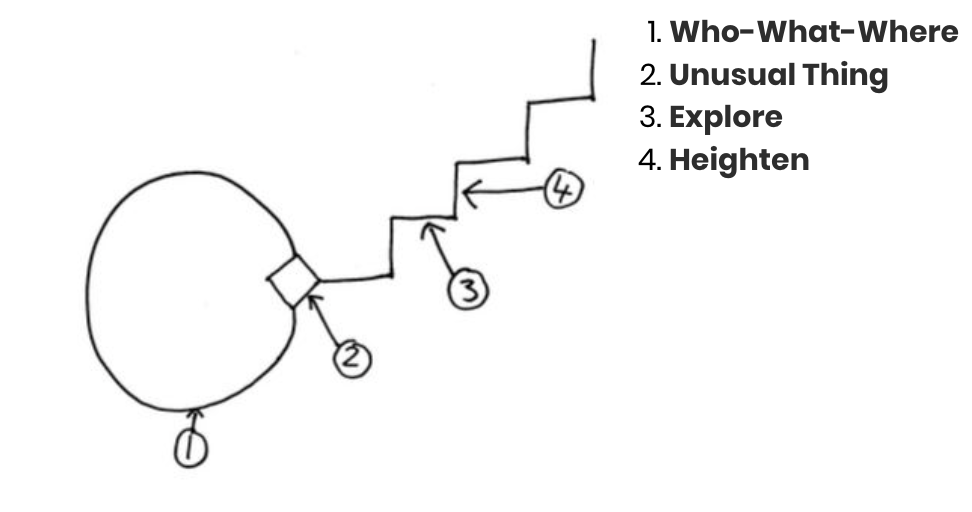Comedy Sketches
This is a short summary of the theory you need to know about writing (or improvising) comedy sketches.
What are comedy sketches?
A sketch is a short, self-contained, funny scene. It is focused on exploring a single comedic idea (called "The Game") - one unusual thing that heightens to comedic absurdity.
What is The Game?
The game is a consistent pattern of unusual behavior that breaks from the expected patterns of our everyday lives. If you watch a comedy sketch, and summarize what’s funny about it in one sentence - that is its game.
Some examples of games:
- Philosophical Truth or Dare - Girls are playing a Truth or Dare game, where the “Truth” means big, philosophical truth, like “are humans inherently good?”
- Dead Parrot - Man tries to return a dead parrot to a pet store.
- Boarding a Plane Shouldn’t Be This Hard - A passenger in “Boarding Group 1” gets frustrated when he must wait as more and more unexpected groups get to board the plane before he can.
- The Audition - A pair of casting agents are continually confused by an actor’s monologue that is indistinguishable from the act of auditioning itself.
Each of these bullet points describes something unusual that repeatedly affects our characters. Even if you’ve never seen these sketches, you can read these sentences and understand what’s funny about the sketch. Every moment of the sketch supports this same repeating idea.
The purpose of the game is to make your life easier by forcing you to focus on a single comic idea - you don’t have to come up with new funny things to add to the scene, you only need to heighten and explore what’s already there. As you’re playing the Game, make sure to avoid introducing new absurd elements unrelated to the one created by the First Unusual Thing.
Base Reality
The first step to creating a comedy sketch is to establish the "Base Reality" of your scene - the “Who, What, and Where”, a believable, somewhat realistic situation that isn’t trying to be funny, it is the normal ordinary world you create so that anything funny or unusual can clearly stand out in contrast to it.
The way jokes have a setup and a punchline, sketches have “base reality” (an ordinary world we establish at the beginning), and “the game” (which, just like a punchline, breaks the pattern of the ordinary reality we have established).
Finding the First Unusual Thing
Once the base reality is established, you need to find and play the Game. The key to finding and playing the Game is identifying the First Unusual Thing in a scene - some behavior or a piece of information that breaks from the pattern of normal life, something out of the ordinary in the context of Base Reality. This is the absurd element in your scene, and The Game will be focused on heightening and exploring this absurdity.
Often, the First Unusual Thing comes up organically, but you can also create it deliberately - by exaggerating some aspect of the scene, or doing the opposite of what’s expected, or adding some absurd element to the environment or the character.
Heightening and Exploring
Once the First Unusual Thing has been found, we no longer need to develop the Base Reality, we can shift to playing the Game and being funny. To play the game, we do two things: Heightening and Exploring.

1. Heightening
We build on the absurd aspect introduced by the First Unusual Thing by using heightening and exaggeration. Heightening is “the act of making a Game move that is more absurd than anything that has preceded it”, each heightened game move deviates even further from the expected pattern of reality.
To do that, ask yourself “If this unusual thing is true, then what else is true?”. Repeatedly answering this question creates a comedic pattern.
2. Exploring
The other key component for playing the game is exploration - justifying your game moves with logical rationale, explaining why your character (or your scene partner) is making absurd choices, providing reasonable explanations for the absurdity. That grounds the scene in reality, making the absurd believable, making it make sense.
Player 1
So… my big news is… I am in love with a dolphin.
Player 2
Well, dolphins are smarter than most people, and have superior hearing. I can see how she would be able to understand you more than any human you’ve ever dated.
You justify the absurdity by answering “If this absurd thing is true, then why is it true?”, and trying to find answers that make sense. These logical answers, juxtaposed with the absurd behavior, make the scene even funnier.
Sketch Structure
So, your sketch should have an unusual pattern (the game). Every time we revisit the unusual thing, it should get more exaggerated (heightening), and every moment in between should add more logically consistent details (exploring).
-
Start the sketch by establishing the base reality.
-
Introduce The First Unusual Thing.
-
Heighten+Explore it 3 times, making it increasingly absurd.
-
End the sketch once you have heightened the game as much as possible, and made it as absurd as it can be.
Read More
The Basics #1: What Is A Sketch and How Does It Work?
The Basics #2: Surprising Truth
The Basics #3: Where Do You Get Your Ideas?
The Basics #4: Brainstorming and outlining
The Basics #5: Turning a Blank Page into a Rough Draft
Dissecting "Philosophical Truth or Dare" (excellent sketch example)
A quick guide to Game of the Scene
UCB Manual (audio version) - the ultimate, book-length explanation of improv comedy that delves deep into what “The Game” is, how to find and play it.
Step by Step to Stand-up Comedy (audio version) - an excellent book about joke writing.